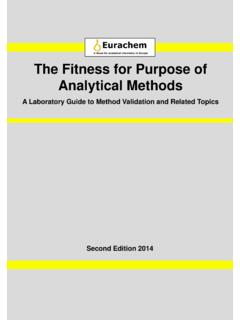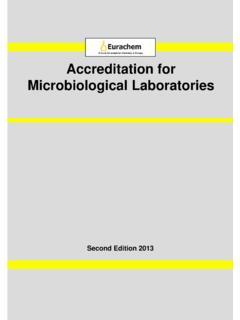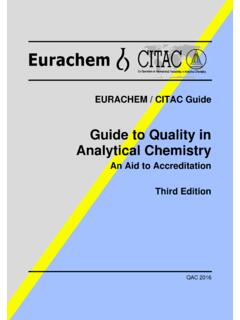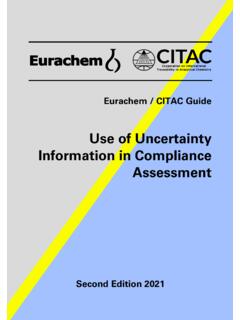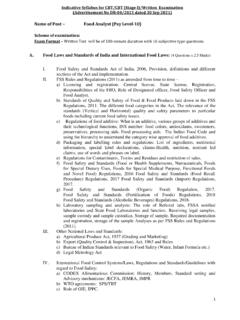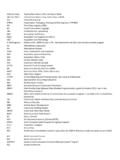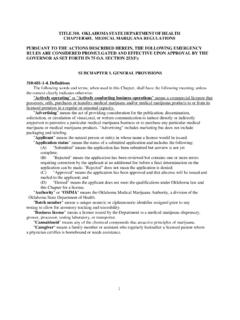Transcription of Quantifying Uncertainty in Analytical Measurement
1 EURACHEM / CITAC Guide CG 4 Quantifying Uncertainty in Analytical Measurement Third Edition EURACHEM/CITAC Guide Quantifying Uncertainty in Analytical Measurement Third Edition Editors S L R Ellison (LGC, UK) A Williams (UK) Composition of the Working Group* EURACHEM members A Williams Chairman UK S Ellison Secretary LGC, Teddington, UK R Bettencourt da Silva University of Lisbon, Portugal W Bremser BAM, Germany A Brzyski Eurachem Poland P Fodor Corvinus University of Budapest, Hungary R Kaarls Netherlands Measurement Institute, The Netherlands R Kaus Eurachem Germany B Magnusson SP, Sweden E Amico di Meane Italy P Robouch IRMM, EU M R sslein EMPA St. Gallen, Switzerland A van der Veen Netherlands Measurement Institute, The Netherlands M Walsh Eurachem IRE W Wegscheider Montanuniversitaet, Leoben, Austria R Wood Food Standards Agency, UK P Yolci Omeroglu Istanbul Technical University, Turkey CITAC Representatives A Squirrell ILAC I Kuselman National Physical Laboratory of Israel A Fajgelj IAEA Vienna Eurolab Representatives M Golze BAM, Germany *Attending meetings or corresponding in the period 2009-2011 Acknowledgements This document has been produced primarily by a joint EURACHEM/CITAC Working Group with the composition shown (right).
2 The editors are grateful to all these individuals and organisations and to others who have contributed comments, advice and assistance. Production of this Guide was in part supported by the UK National Measurement System. CITAC Reference This Guide constitutes CITAC Guide number 4 Quantifying Uncertainty Contents Page i CONTENTS FOREWORD TO THE THIRD EDITION 1 1. SCOPE AND FIELD OF APPLICATION 3 2. Uncertainty 4 DEFINITION OF Uncertainty 4 Uncertainty SOURCES 4 Uncertainty COMPONENTS 4 ERROR AND Uncertainty 5 THE VIM 3 DEFINITION OF Uncertainty 6 3. Analytical Measurement AND Uncertainty 7 METHOD VALIDATION 7 CONDUCT OF EXPERIMENTAL STUDIES OF METHOD PERFORMANCE 8 traceability 9 4. THE PROCESS OF Measurement Uncertainty ESTIMATION 10 5. STEP 1. SPECIFICATION OF THE MEASURAND 12 6.
3 STEP 2. IDENTIFYING Uncertainty SOURCES 14 7. STEP 3. Quantifying Uncertainty 16 INTRODUCTION 16 Uncertainty EVALUATION PROCEDURE 16 RELEVANCE OF PRIOR STUDIES 17 EVALUATING Uncertainty BY QUANTIFICATION OF INDIVIDUAL COMPONENTS 17 CLOSELY MATCHED CERTIFIED REFERENCE MATERIALS 17 Uncertainty ESTIMATION USING PRIOR COLLABORATIVE METHOD DEVELOPMENT AND VALIDATION STUDY DATA 17 Uncertainty ESTIMATION USING IN"HOUSE DEVELOPMENT AND VALIDATION STUDIES 18 USING DATA FROM PROFICIENCY TESTING 20 EVALUATION OF Uncertainty FOR EMPIRICAL METHODS 21 EVALUATION OF Uncertainty FOR AD"HOC METHODS 22 QUANTIFICATION OF INDIVIDUAL COMPONENTS 22 EXPERIMENTAL ESTIMATION OF INDIVIDUAL Uncertainty CONTRIBUTIONS 22 ESTIMATION BASED ON OTHER RESULTS OR DATA 23 MODELLING FROM THEORETICAL PRINCIPLES 23 ESTIMATION BASED ON JUDGEMENT
4 24 SIGNIFICANCE OF BIAS 25 8. STEP 4. CALCULATING THE COMBINED Uncertainty 26 STANDARD UNCERTAINTIES 26 COMBINED STANDARD Uncertainty 26 EXPANDED Uncertainty 28 Quantifying Uncertainty Contents Page ii 9. REPORTING Uncertainty 30 GENERAL 30 INFORMATION REQUIRED 30 REPORTING STANDARD Uncertainty 30 REPORTING EXPANDED Uncertainty 30 NUMERICAL EXPRESSION OF RESULTS 31 ASYMMETRIC INTERVALS 31 COMPLIANCE AGAINST LIMITS 31 APPENDIX A. EXAMPLES 33 EXAMPLE A1: PREPARATION OF A CALIBRATION STANDARD 35 EXAMPLE A2: STANDARDISING A SODIUM HYDROXIDE SOLUTION 41 EXAMPLE A3: AN ACID/BASE TITRATION 51 EXAMPLE A4: Uncertainty ESTIMATION FROM IN"HOUSE VALIDATION STUDIES. DETERMINATION OF ORGANOPHOSPHORUS PESTICIDES IN BREAD. 60 EXAMPLE A5: DETERMINATION OF CADMIUM RELEASE FROM CERAMIC WARE BY ATOMIC ABSORPTION SPECTROMETRY 72 EXAMPLE A6: THE DETERMINATION OF CRUDE FIBRE IN ANIMAL FEEDING STUFFS 81 EXAMPLE A7: DETERMINATION OF THE AMOUNT OF LEAD IN WATER USING DOUBLE ISOTOPE DILUTION AND INDUCTIVELY COUPLED PLASMA MASS SPECTROMETRY 89 APPENDIX B.
5 DEFINITIONS 97 APPENDIX C. UNCERTAINTIES IN Analytical PROCESSES 101 APPENDIX D. ANALYSING Uncertainty SOURCES 102 APPENDIX E. USEFUL STATISTICAL PROCEDURES 104 DISTRIBUTION FUNCTIONS 104 SPREADSHEET METHOD FOR Uncertainty CALCULATION 106 EVALUATION OF Uncertainty USING MONTE CARLO SIMULATION 108 UNCERTAINTIES FROM LINEAR LEAST SQUARES CALIBRATION 115 DOCUMENTING Uncertainty DEPENDENT ON ANALYTE LEVEL 117 APPENDIX F. Measurement Uncertainty AT THE LIMIT OF DETECTION/ LIMIT OF DETERMINATION 121 APPENDIX G. COMMON SOURCES AND VALUES OF Uncertainty 126 APPENDIX H. BIBLIOGRAPHY 132 Quantifying Uncertainty Page 1 Foreword to the Third Edition Many important decisions are based on the results of chemical quantitative analysis; the results are used, for example, to estimate yields, to check materials against specifications or statutory limits, or to estimate monetary value.
6 Whenever decisions are based on Analytical results, it is important to have some indication of the quality of the results, that is, the extent to which they can be relied on for the purpose in hand. Users of the results of chemical analysis, particularly in those areas concerned with international trade, are coming under increasing pressure to eliminate the replication of effort frequently expended in obtaining them. Confidence in data obtained outside the user s own organisation is a prerequisite to meeting this objective. In some sectors of Analytical chemistry it is now a formal (frequently legislative) requirement for laboratories to introduce quality assurance measures to ensure that they are capable of and are providing data of the required quality. Such measures include: the use of validated methods of analysis; the use of defined internal quality control (QC) procedures; participation in proficiency testing (PT) schemes; accreditation based on ISO/IEC 17025 [ ], and establishing traceability of the results of the measurements.
7 In Analytical chemistry, there has been great emphasis on the precision of results obtained using a specified method, rather than on their traceability to a defined standard or SI unit. This has led the use of official methods to fulfil legislative and trading requirements. However as there is a formal requirement to establish the confidence of results it is essential that a Measurement result is traceable to defined references such as SI units or reference materials even when using an operationally defined or empirical (sec. ) method. The Eurachem/CITAC Guide traceability in chemical Measurement [ ] explains how metrological traceability is established in the case of operationally defined procedures. As a consequence of these requirements, chemists are, for their part, coming under increasing pressure to demonstrate the quality of their results, and in particular to demonstrate their fitness for purpose by giving a measure of the confidence that can be placed on the result.
8 This is expected to include the degree to which a result would be expected to agree with other results, normally irrespective of the Analytical methods used. One useful measure of this is Measurement Uncertainty . Although the concept of Measurement Uncertainty has been recognised by chemists for many years, it was the publication in 1993 of the Guide to the Expression of Uncertainty in Measurement (the GUM) [ ] by ISO in collaboration with BIPM, IEC, IFCC, ILAC, IUPAC, IUPAP and OIML, which formally established general rules for evaluating and expressing Uncertainty in Measurement across a broad spectrum of measurements. This EURACHEM/CITAC document shows how the concepts in the ISO Guide may be applied in chemical Measurement . It first introduces the concept of Uncertainty and the distinction between Uncertainty and error.
9 This is followed by a description of the steps involved in the evaluation of Uncertainty with the processes illustrated by worked examples in Appendix A. The evaluation of Uncertainty requires the analyst to look closely at all the possible sources of Uncertainty . However, although a detailed study of this kind may require a considerable effort, it is essential that the effort expended should not be disproportionate. In practice a preliminary study will quickly identify the most significant sources of Uncertainty and, as the examples show, the value obtained for the combined Uncertainty is almost entirely controlled by the major contributions. A good estimate of Uncertainty can be made by concentrating effort on the largest contributions. Further, once evaluated for a given method applied in a particular laboratory ( a particular Measurement procedure), the Uncertainty estimate obtained may be reliably applied to subsequent results obtained by the method in the same laboratory, provided that this is justified by the relevant quality control data.
10 No further effort should be necessary unless the procedure itself or the equipment used is changed, in which case the Uncertainty estimate would be reviewed as part of the normal re"validation. Method development involves a similar process to the evaluation of Uncertainty arising from each individual source; potential sources of Uncertainty are investigated and method adjusted to reduce the Uncertainty to an acceptable level where possible. (Where specified as a numerical upper limit for Uncertainty , the acceptable Quantifying Uncertainty Foreword to the Third Edition Page 2 level of Measurement Uncertainty is called the target Measurement Uncertainty [ ]). The performance of the method is then quantified in terms of precision and trueness. Method validation is carried out to ensure that the performance obtained during development can be achieved for a particular application and if necessary the performance figures adjusted.



